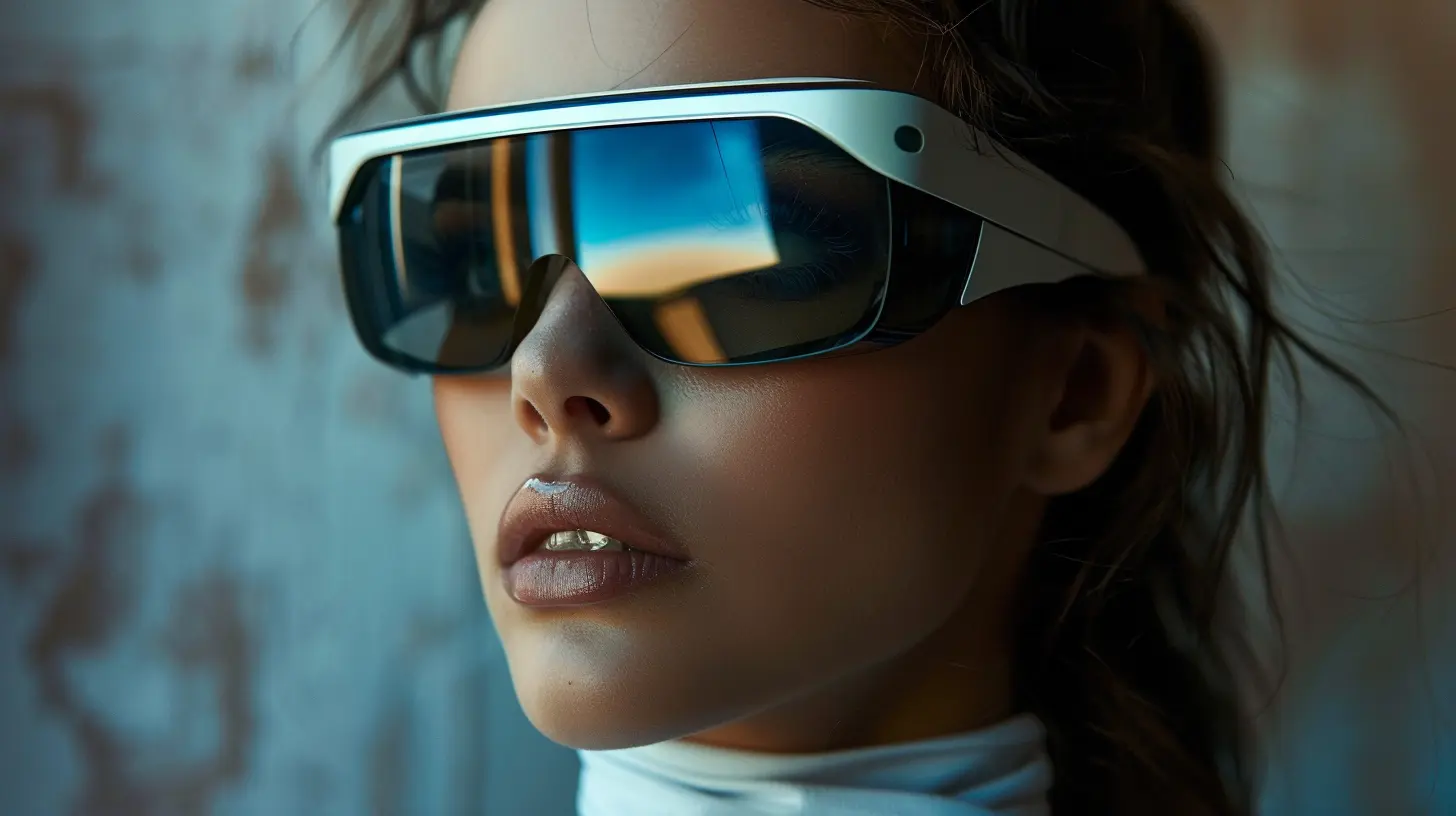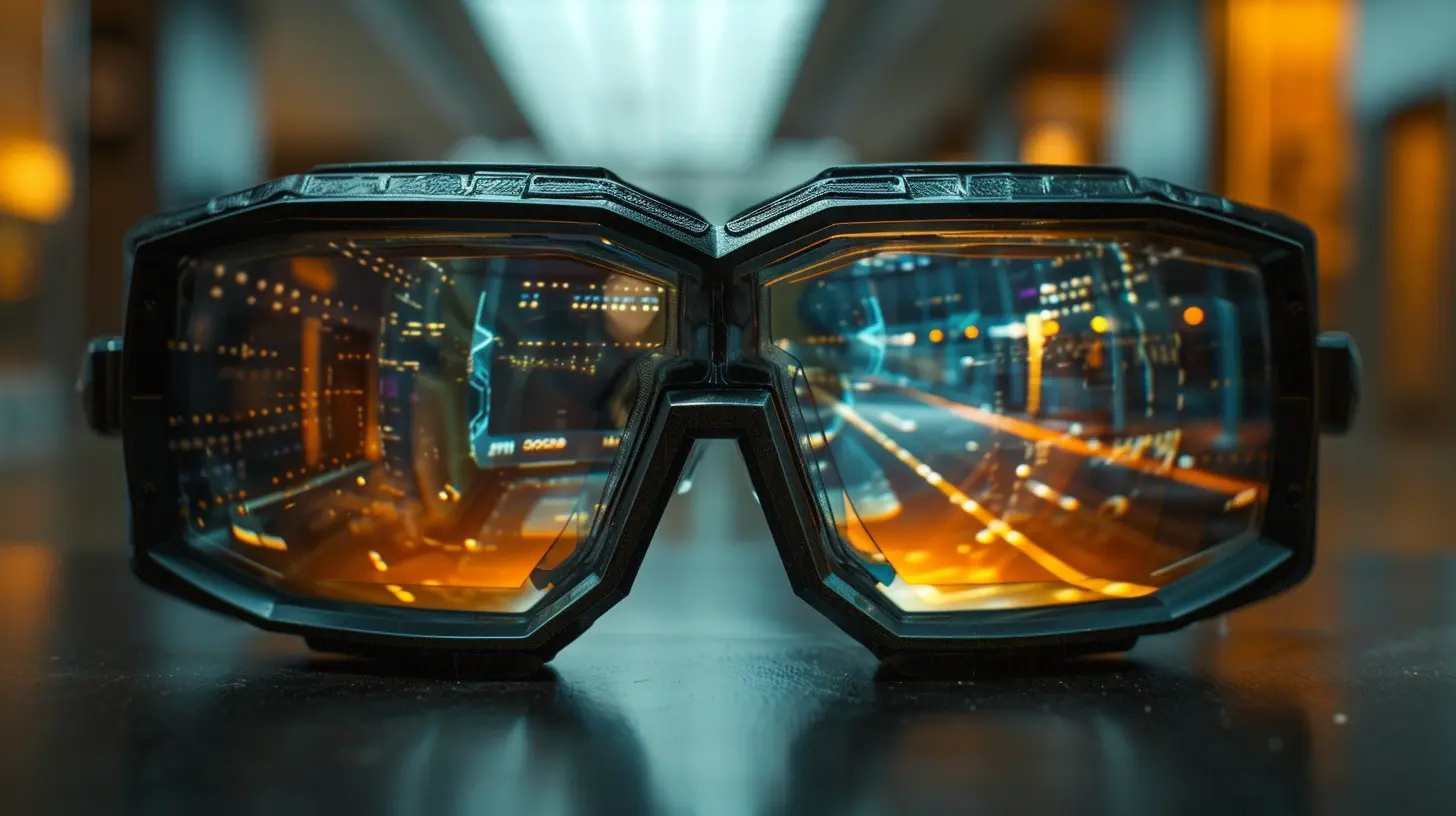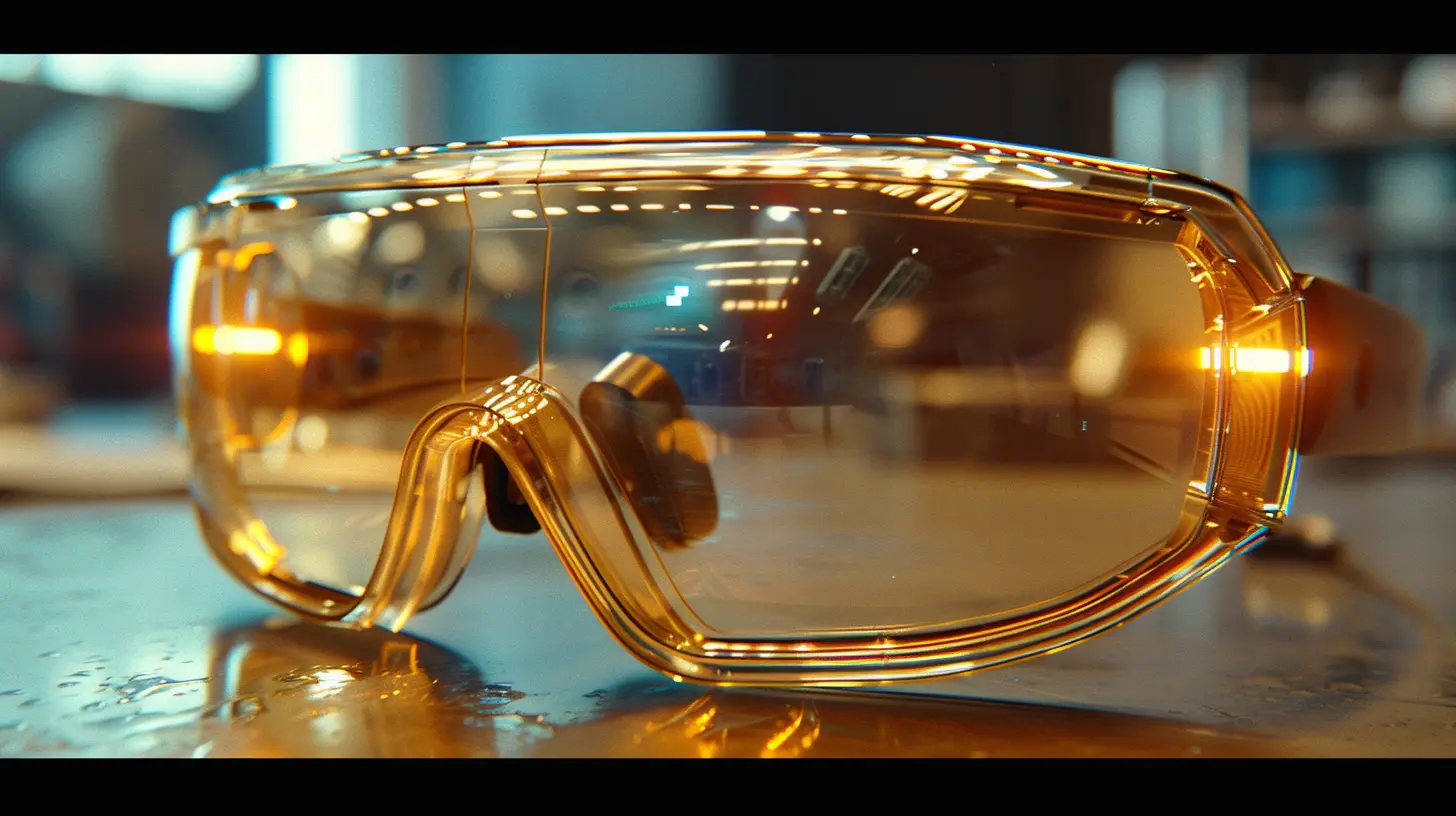AR Glasses in the Film Industry: A New Cinematic Experience
7 March 2025
Imagine sitting in a theater, your popcorn in one hand, and as the lights dim, the screen in front of you transforms into not just a window into another world, but an entirely immersive experience that feels like you’re inside the film. Sounds like something out of a futuristic sci-fi movie, right? Not anymore! With the rise of Augmented Reality (AR) glasses, this kind of experience is quickly becoming a reality.
AR glasses are not just another cool gadget for gaming or navigation; they are poised to revolutionize the film industry. From the way movies are made to how we watch them, AR glasses offer a completely new cinematic experience—one that’s interactive, immersive, and just plain fun.
But how exactly do AR glasses fit into the world of filmmaking? And more importantly, how will they change the way we as viewers engage with movies? Let’s dive into this fascinating topic and explore the potential of AR glasses in the film industry.

The Evolution of AR Glasses
Before we get into the nitty-gritty of how AR glasses will change the film industry, let’s take a step back and talk about what AR glasses actually are. AR, or Augmented Reality, is a technology that overlays digital content—like images, videos, or data—onto the real world. Unlike Virtual Reality (VR), which creates an entirely new digital environment, AR enhances the world around you.AR glasses are essentially wearable devices that allow you to interact with this blended reality. Initially, AR glasses were bulky, expensive, and somewhat limited in functionality. But recent advancements have made them sleeker, more affordable, and packed with features that make them more accessible to consumers and industries like filmmaking.
The Journey from Sci-Fi to Reality
The concept of AR glasses isn’t new. Science fiction movies have been teasing us with the idea for decades—think of Tony Stark’s heads-up display in Iron Man or the futuristic, data-filled glasses worn by characters in Minority Report. Those futuristic visions are now within our grasp. Companies like Microsoft, Google, and Apple are all working on AR glasses, and it’s only a matter of time before this tech becomes mainstream.In fact, AR glasses have already found their way into industries like gaming, healthcare, and education. But the film industry? That’s where things get really interesting.

How AR Glasses Are Transforming Film Production
Let’s start with the behind-the-scenes magic. Filmmaking has always been about pushing the boundaries of technology. From the introduction of sound in films to the shift from black-and-white to color, filmmakers have consistently adopted new technologies to tell better stories. AR glasses are the next big leap.Enhancing Pre-Production and Planning
One of the most time-consuming parts of filmmaking is pre-production—the planning and designing of sets, camera angles, and shots. Directors and producers spend hours visualizing scenes and figuring out how everything will look once it's filmed. AR glasses can streamline this process.With AR glasses, directors can get a live, 3D preview of how a scene will look, right there on set. Imagine being able to visualize a massive explosion, not as a vague concept in your head, but as a real-time overlay in the actual physical space. It’s like having a digital storyboard that you can walk through, tweak, and perfect before a single camera rolls.
Immersive Set Designs
Set designers can also benefit from AR glasses. Rather than relying solely on computer-generated models or physical blueprints, designers can use AR glasses to see how their set pieces will look in the actual space. This allows them to make adjustments in real time, ensuring that everything from lighting to prop placement is perfect before the actors even show up.Actor Training and Performance
AR glasses can also be a game-changer for actors. Imagine having digital cues, character animations, or even virtual co-stars right in front of you while rehearsing. This could help actors immerse themselves in their roles better, especially when working with green screens or motion capture technology where a lot of imagination is required.
AR Glasses and Post-Production: A New Approach to Editing
In post-production, AR glasses can help editors and visual effects artists speed up their workflow. Rather than being glued to a computer screen, artists can use AR glasses to interact with the 3D models and effects in a more natural, intuitive way. This can lead to faster turnaround times and higher-quality visual effects.For example, imagine being able to physically manipulate a CGI creature in your workspace, scaling it, rotating it, or changing its texture just by moving your hands. That’s the kind of power AR glasses can bring to post-production.

The Audience Experience: A New Kind of Cinema
Now that we’ve covered how AR glasses can change the filmmaking process, let’s talk about what really matters: the audience experience. This is where things get exciting.Interactive Viewing
AR glasses could turn passive movie-watching into an interactive experience. Rather than just sitting back and watching a film unfold on a flat screen, viewers equipped with AR glasses could explore different perspectives and interact with the story in real-time. Imagine watching a murder mystery where you can walk around the crime scene, examine clues, and maybe even solve the mystery yourself!Personalized Content
AR glasses could allow for personalized content as well. Ever watched a movie and wished you could see a different version of a scene or follow a side character’s story? With AR glasses, filmmakers could create multiple storylines or perspectives that viewers can switch between on the fly.Think of it like a “choose-your-own-adventure” style of movie, but instead of flipping pages, you’re switching between different realities, all overlaid in front of you.
Expanding Beyond the Screen
One of the most exciting possibilities of AR glasses in cinema is the way they could expand the viewing experience beyond the confines of the traditional movie screen. Imagine sitting in a theater, watching a sci-fi film, and suddenly spaceships start flying around the room, not just on the screen, but all around you. Or in a horror movie, the ghosts aren’t just confined to the screen—they’re stalking you in the aisles too.These kinds of experiences could make going to the movies feel more like stepping into a theme park attraction. It’s not hard to imagine the film industry partnering with AR hardware companies to create these immersive experiences.
AR Glasses and the Future of Home Entertainment
It’s not just theaters that stand to benefit from AR glasses. Home entertainment is also set to change in a big way. As AR glasses become more affordable and mainstream, it’s likely that we’ll start seeing AR-enhanced films being released for home viewing.Imagine watching Jurassic Park in your living room and having a T-Rex stomp through your coffee table. Or watching Harry Potter and having magical creatures fly around your room. This level of immersion isn’t possible with traditional TV screens, but with AR glasses, your living room becomes part of the movie.
Challenges and Limitations
Of course, as with any new technology, AR glasses have their challenges. For starters, there’s the issue of hardware. While AR glasses are becoming more affordable, they’re still not as accessible as smartphones or regular glasses. There’s also the concern of comfort—will people want to wear glasses for the entire duration of a two-hour movie?Battery life is another issue. AR glasses are power-hungry devices, and watching a full-length movie with all the immersive features could drain the battery quickly. And let’s not forget content creation. Filmmakers will need to adapt to this new medium, learning how to create stories that take full advantage of AR technology.
Finally, there’s the question of whether audiences want this level of interactivity. Some people might prefer the traditional, passive movie-watching experience. After all, not everyone wants to be that involved in the story.
Final Thoughts: A New Era in Cinema?
AR glasses represent a new frontier in the film industry. From changing the way movies are made to transforming how we watch them, it’s clear that this technology has the potential to revolutionize cinema. While there are still challenges to overcome, the possibilities are endless.Will AR glasses replace traditional movies? Probably not. But they will almost certainly become a new way to experience film, offering a level of immersion and interactivity that’s never been possible before. So, the next time you put on your AR glasses, you might just find yourself stepping into a whole new cinematic world—one where the line between film and reality is blurred in the best possible way.
all images in this post were generated using AI tools
Category:
Ar GlassesAuthor:

Gabriel Sullivan
Discussion
rate this article
21 comments
Harrison Brooks
AR glasses in film? What a thrilling concept! Imagine blending storytelling with interactive experiences—like being part of the movie! It’s exciting to think how this technology could transform our viewing habits and create unforgettable moments. Can’t wait to see where this innovation takes us!
April 7, 2025 at 2:37 AM

Gabriel Sullivan
Absolutely! AR glasses have the potential to revolutionize storytelling, making viewers active participants in the narrative. It's an exciting frontier for cinema!
Vito Wilkerson
AR glasses could revolutionize filmmaking by blending digital elements with live action, enhancing storytelling and viewer immersion. Exciting potential awaits both creators and audiences alike!
April 6, 2025 at 3:35 AM

Gabriel Sullivan
Absolutely! AR glasses offer thrilling possibilities for filmmakers to create immersive narratives that engage audiences like never before. It's an exciting frontier for storytelling!
Kova Estes
AR glasses could revolutionize storytelling, blending reality with imagination, but the challenge lies in creating immersive experiences that captivate audiences.
April 4, 2025 at 3:48 AM

Gabriel Sullivan
Absolutely! AR glasses have the potential to transform storytelling by merging the real and imaginary, but the key challenge will be crafting truly immersive experiences that engage viewers fully.
Maxwell Nguyen
Exciting advancements! AR glasses could revolutionize storytelling in film, enhancing viewer engagement and creativity. Can't wait!
March 31, 2025 at 2:33 AM

Gabriel Sullivan
Thank you! We're thrilled about the potential of AR glasses to transform storytelling and deepen viewer engagement in film. Stay tuned for more innovations!
Corin Jennings
This article offers a fascinating insight into the potential of AR glasses in filmmaking. The integration of this technology could truly transform viewer engagement and storytelling in cinema.
March 30, 2025 at 8:31 PM

Gabriel Sullivan
Thank you! I'm glad you found the article insightful. AR glasses indeed hold exciting potential for transforming storytelling in filmmaking.
Antonia Webster
This article offers an intriguing perspective on AR glasses in filmmaking. The potential for immersive storytelling is exciting, but practical challenges remain. It will be interesting to see how directors and creators adapt this technology to enhance viewer engagement without compromising traditional cinematic elements.
March 25, 2025 at 10:01 PM

Gabriel Sullivan
Thank you for your insightful comment! I agree that while AR glasses present exciting opportunities for immersive storytelling, overcoming practical challenges will be key to blending this technology with traditional cinema. It will be fascinating to see how creators innovate in this space.
Zinna Maddox
Fascinating exploration of AR glasses in filmmaking! It’s exciting to imagine how this technology could redefine storytelling and audience engagement. I wonder how filmmakers will balance creative visions with the technical limitations of AR. Looking forward to seeing how this evolves in cinema!
March 25, 2025 at 4:24 AM

Gabriel Sullivan
Thank you for your thoughtful comment! I share your excitement about the potential of AR glasses to transform storytelling in film, and it's definitely a challenge for filmmakers to balance creativity with technology. It will be fascinating to watch this evolution unfold!
Preston McAllister
This article beautifully highlights the innovative potential of AR glasses in filmmaking. Excited to see how this technology transforms storytelling and viewer engagement in cinema!
March 24, 2025 at 8:57 PM

Gabriel Sullivan
Thank you! I'm thrilled you enjoyed the article and share your excitement about the possibilities AR glasses bring to filmmaking and storytelling!
Benjamin McFadden
This article highlights the transformative potential of AR glasses in filmmaking. While the technology promises to enhance audience immersion and storytelling, it also raises questions about accessibility and the future of traditional cinema. It's exciting yet crucial to consider how these innovations will reshape both production and audience experience.
March 24, 2025 at 4:46 AM

Gabriel Sullivan
Thank you for your insightful comment! Indeed, AR glasses have the potential to revolutionize filmmaking, but we must also address accessibility and the impact on traditional cinema. It's an exciting frontier that requires careful consideration.
Kingston Cross
Exciting times ahead for cinema with AR glasses!
March 22, 2025 at 3:29 AM

Gabriel Sullivan
Absolutely! AR glasses have the potential to revolutionize storytelling and audience engagement in cinema. Exciting times indeed!
Odessa Pruitt
Imagine a world where actors wear AR glasses, dodging virtual dinosaurs while delivering dramatic monologues! 🎬🦖 The film industry is stepping into a dimension where reality meets imagination—where your popcorn could be a holographic snack. Can’t wait for my next cinematic adventure!
March 21, 2025 at 7:59 PM

Gabriel Sullivan
Absolutely! The fusion of AR technology with film promises a revolutionary experience, merging imagination with interactive storytelling. Can't wait to see how it transforms cinema! 🎥✨
Cypher Hines
Exciting times ahead! AR glasses will redefine storytelling, immersing audiences in unforgettable cinematic journeys. Elevate your experience!
March 19, 2025 at 9:28 PM

Gabriel Sullivan
Thank you! I agree—AR glasses have the potential to transform storytelling, creating immersive experiences that truly engage audiences like never before.
Zanya Harris
What an exciting exploration of AR glasses in filmmaking! The potential to enhance storytelling and viewer immersion is incredible. Can't wait to see how this technology transforms our cinematic experiences in the future!
March 18, 2025 at 8:30 PM

Gabriel Sullivan
Thank you! I'm thrilled about the possibilities AR glasses bring to storytelling and can't wait to see how filmmakers leverage this technology to elevate the viewer experience.
Elowyn Chapman
Exciting prospects for AR glasses in film! I’m curious how they'll transform storytelling and audience engagement in the future.
March 16, 2025 at 5:09 AM

Gabriel Sullivan
Thank you! AR glasses indeed have the potential to revolutionize storytelling by immersing audiences in interactive narratives and enhancing their connection to the film world. Exciting times ahead!
Elara Bailey
In a symphony of sight and sound, AR glasses weave dreams, profound. Through cinematic lenses, stories unfold, Where realms of fantasy and reality hold. A dance of innovation, a visual embrace, The future of film, a thrilling chase. Artistry reborn in this digital space.
March 15, 2025 at 12:29 PM

Gabriel Sullivan
Thank you for your poetic insights! Indeed, AR glasses are reshaping cinematic storytelling, blending imagination with technology in exciting new ways.
Rune McNab
Because who needs real actors when you can just project holograms? Welcome to the future of lazy filmmaking!
March 14, 2025 at 8:32 PM

Gabriel Sullivan
Holograms can enhance storytelling, not replace actors. The future of filmmaking is about innovation, not laziness!
Mitchell Whitaker
AR glasses could revolutionize filmmaking by enhancing storytelling, enabling immersive environments, and providing audiences with unique perspectives, ultimately reshaping the cinematic experience.
March 10, 2025 at 7:15 PM

Gabriel Sullivan
Absolutely! AR glasses have the potential to transform filmmaking by creating immersive narratives and engaging audiences in ways we’ve never seen before. Exciting times ahead!
Matteo Wood
AR glasses are revolutionizing the film industry, offering immersive experiences that blend reality with storytelling. This technology has the potential to transform how audiences engage with cinema like never before.
March 9, 2025 at 12:15 PM

Gabriel Sullivan
Thank you for your insight! I agree that AR glasses are indeed set to transform audience engagement and storytelling in film.
Otis Dillon
AR glasses offer exciting possibilities for the film industry, enhancing storytelling and viewer engagement. However, challenges like cost and accessibility must be addressed for widespread adoption.
March 8, 2025 at 8:39 PM

Gabriel Sullivan
Thank you for your insightful comment! I completely agree that while AR glasses hold great promise for enhancing storytelling in film, addressing cost and accessibility is crucial for their widespread use.
Juniper McCarron
How will storytelling evolve?
March 8, 2025 at 12:10 PM

Gabriel Sullivan
Storytelling will evolve by integrating immersive technologies, allowing audiences to engage with narratives interactively and experience stories from multiple perspectives, enhancing emotional connections and creativity in cinema.
Daniel McInnes
AR glasses revolutionize storytelling, enhancing viewer engagement and immersion.
March 8, 2025 at 3:38 AM

Gabriel Sullivan
Thank you! AR glasses truly offer a groundbreaking way to engage audiences, transforming storytelling into a more immersive and interactive experience.
MORE POSTS

The Role of AR Glasses in Enhancing Military Operations

How AI is Revolutionizing Cybersecurity Defenses

The Best IoT Devices to Modernize Your Office

AR Glasses and the Future of Communication

The Growing Threat of Deepfakes: A New Challenge for Cybersecurity

How to Build a Secure Cloud Migration Strategy

The Intersection of AI and Ethics: Navigating the Complexities

Amazon Echo vs. Google Nest: Best Smart Speaker for Your Home

Exploring the Future: Upcoming Tech Conferences You Shouldn't Miss

The Role of GPUs in Data Center AI Workloads

How to Use a VPN to Bypass Geo-Restrictions and Censorship

Will MicroLED Displays Replace OLED in the Near Future?

The Role of Virtual Reality in Healthcare and Therapy